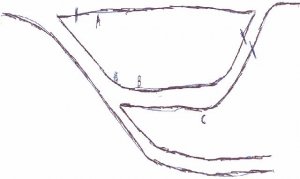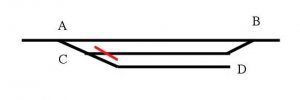an electrician.
Sorry about the crummy drawing, but without a camera it's kind of difficult to explain the situation in order to pose a question. (Please ignore the "dots" at the left side of the diagram: it was the only way I could think of to keep the rest of the diagram from shifting to the left when this is posted.
..M____a___________________________________________b_________N
,............X................................................................X
.............c.X_____________________________________X..................X
.....................X_______________________D
Line "M" - "N" is part of a main line (a complete loop around the room), with power feeds at M and N. All turnouts are Peco power routing type. With the turnouts at "a" and "b" aligned for the main, there is no power on the passing siding a-c-b or on the spur c-D. When either turnout "a" or "b" is aligned for the passing siding, along with "c", the passing siding is powered. The spur, c-D remains dead. So far, so good. However, with turnout "b" aligned for the main, and turnouts "a" and "c" aligned for the spur c-D, the passing track remains energized. I understand why this is so (the near rail of the passing siding is powered through switch "b", and the far rail is powered through switches "a" and "c"). (Spur c-D becomes energized as it should). To be able to keep a locomotive parked on the passing siding while another loco switches the spur, where do I need to cut the gap(s)? Since this is on the layout of a friend that I'm supposed to be helping, I'm reluctant to start hacking away without a few second opinions. Comments, please?
Wayne



